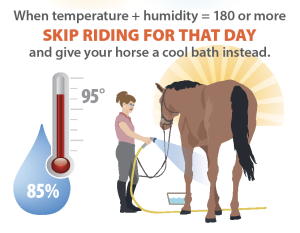When Is It Too Hot to Ride Your Horse?
To ride or not to ride, that is the question.
Temperature alone is not a good guide when it comes to deciding if you should ride on a hot summer day. It is the combination of heat and humidity that should be your major concern. Your horse’s natural radiator is a combination of skin surface and sweat. As your horse’s body warms up, his sweat glands release sweat:
a combination of water and minerals. As the water evaporates off the skin it cools the body down. When the relative humidity (a measurement of moisture in  the air) is over 75%, the ability of your horse to cool himself by sweating is greatly diminished. This occurs because the air is so full of moisture your horse’s sweat can no longer properly evaporate and cause cooling. While high heat (85°F or higher) or high humidity (above 80%) alone is not a problem, the combination of high heat and high humidity should raise red flags. If the combination of the temperature and the humidity (temperature + humidity) is over 180, skip riding for that day and give your horse a cool bath instead.
the air) is over 75%, the ability of your horse to cool himself by sweating is greatly diminished. This occurs because the air is so full of moisture your horse’s sweat can no longer properly evaporate and cause cooling. While high heat (85°F or higher) or high humidity (above 80%) alone is not a problem, the combination of high heat and high humidity should raise red flags. If the combination of the temperature and the humidity (temperature + humidity) is over 180, skip riding for that day and give your horse a cool bath instead.
When and where to ride during
warm weather
You have checked the temperature and humidity and it is not in the danger zone, but it is still hot. There are choices you can make that will keep both you and your horse more comfortable during your ride.
- Feed an electrolyte daily during hot weather. It will stimulate your horse to drink and help keep him or her hydrated. Electrolytes also replace the essential minerals lost in sweat.
- Ride in the early morning or in the evening when the sun is not at its hottest.
- Ride in the shade, either in the woods or in an indoor arena, with good air circulation.
- Be aware of your horse’s fitness level. Whether obese or thin, unfit horses are less able to deal with the stress of exercising in hot temperatures.
- Cool your horse down properly after your ride and be sure an abundant supply of cool, fresh water is always available.



